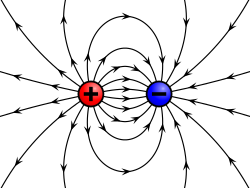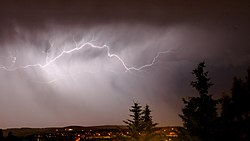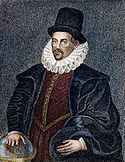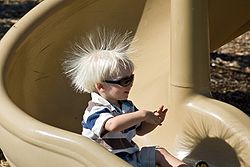Electroscope showing induction
Autor/Urheber:
- Original version: Sylvanus P. Thompson
- Derived version: Chetvorno
Shortlink:
Quelle:
Größe:
797 x 684 Pixel (38374 Bytes)
Beschreibung:
Drawing of a gold leaf electroscope, an antique scientific instrument invented in 1787 by British clergyman Abraham Bennett that detects electric charge. It consists of a pair of delicate gold leaves hanging parallel to each other from a brass post, protected by a glass jar. The brass post projects from the mouth of the jar and ends in an electrode to which charged objects can be applied. When a charge is applied to the post, the leaves, carrying the same charge, repel each other, and diverge into a "V" shape. This example shows electrostatic induction of charge in the instrument by holding a charged dielectric rod near it. The positive charge on the rod causes the mobile charges in the brass post to separate, with negative charges being attracted into the top electrode, while positive charges are repelled into the leaves, causing them to separate. Alterations to image: Added colored plusses and minuses showing areas of charge.
Kommentar zur Lizenz:
Public domain - published in US prior to 1923
Lizenz:
Public domain
Credit:
Relevante Bilder
Relevante Artikel
Elektrische LadungDie elektrische Ladung oder Elektrizitätsmenge ist eine physikalische Größe, die mit der Materie verbunden ist, wie beispielsweise auch die Masse. Sie bestimmt die elektromagnetische Wechselwirkung und damit, wie Materie auf elektrische und magnetische Felder reagiert und diese hervorruft. Ihr Formelzeichen oder ist vom lateinischen Wort ‚quantum‘ abgeleitet. Im Internationalen Einheitensystem (SI) wird die Ladung in der Einheit Coulomb angegeben. .. weiterlesen









